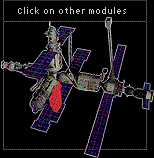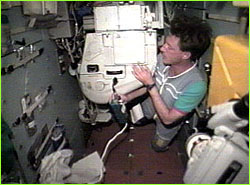 |
 |
 |
Spektr (back to Tour) The Spektr ("Spectrum") module arrived at the Mir complex in May 1995. It was designed for remote sensing of Earth's environment, and contains equipment for atmospheric research and surface studies. The Astra-2 spectrometer measures constituents of the gaseous environment at Mir's altitude; X-ray and gamma-ray detectors measure emissions from the station's passage through Earth's magnetic field. A variety of other spectrometers are also installed. Until late June 1997, Spektr, about the same size as Kristall, served as the living quarters for American astronauts staying on Mir as part of the joint Russian-American program. The module also has four solar panels which before June 1997 generated about half of the station's electrical power. On June 25, 1997, the Progress M-34 spacecraft crashed into Spektr while maneuvering for a docking with Kvant-1. The collision damaged one of Spektr's solar panels and also punctured the hull, depressurizing the module. The module was sealed off from the rest of the station, keeping the rest of the station from losing air but cutting off the power cables that supplied electricity to the rest of the station from Spektr's solar panels. An "internal" spacewalk inside the depressurized module in August 1997 by cosmonauts Anatoly Solovyov and Pavel Vinogradov succeeded in restoring those connections, and a second internal spacewalk by them in October connected two of the panels to a computer system that allows them to be controlled remotely, so they can align with the Sun. Spektr is presently depressurized and isolated from the remainder of the Mir complex. Modifications have been made to the Spektr hatch to allow power and control cable penetrations through the hatch, while still isolating Spektr from the remaining station. These modifications have allowed power generation to return to approximately 70% of the pre-collision conditions. 
Footage: NASA. Q&A | Tour of Mir | Day in the Life Next Space Station | Mishaps | Resources Teacher's Guide | Transcript | Site Map | Terror Home Editor's Picks | Previous Sites | Join Us/E-mail | TV/Web Schedule About NOVA | Teachers | Site Map | Shop | Jobs | Search | To print PBS Online | NOVA Online | WGBH © | Updated November 2000 |
 Spektr: Michael Foale points out large camera.
Spektr: Michael Foale points out large camera.